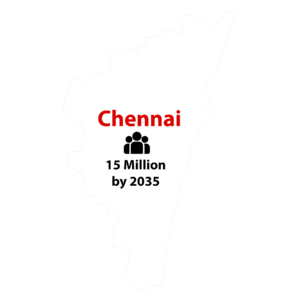ClimACT-Chennai
An initiative on the city’s climate change risks and emergency response
The Earth’s climate is changing. As average temperatures rise, acute hazards such as heat waves and floods grow in frequency and severity, and chronic hazards, such as drought and rising sea levels, intensify. Climate change is already having substantial physical impacts at a local level in regions across the world; the affected climate change could be substantial as a changing climate affects human being, as well as physical and natural capital. Countries and regions with lower per capita GDP levels are generally more at risk.
Forecasts for the next 2 decades
0.7Bn - 1.2Bn
People living in areas
with a 14 percent average
annual likelihood
of lethal heat waves.
2x- 4x
Increase in the amount
of capital stock that
could be damaged from
riverine flooding.
45%
Earth’s land area
projected to experience
climate classification shifts,
impacting ecosystem
and livelihoods
70%
Global glacier mass lost in
the last 20 years. Potential
reduction in water supply
for ~240 million people.

What it means for India
30%
Projected productivity loss
of outdoor work due to
extreme heat and humidity.
~380 million livelihoods
directly impacted.
2x- 4x
People in India who are
vulnerable to extreme
hydromet disasters at
different levels.
45%
Coastal Indian districts that
are extreme event hotspots.
Highest vulnerability for
floods, drought and
cyclones.
70%
Districts that have a
disaster management plan
(DDMP), out of which
32% were updated until
2019.
India is estimated to have suffered losses of almost USD 80 billion due to extreme climate events in the last two
decades. The frequency and intensity of extreme events in India have increased by almost 200% since 2005.
Sources: McKinsey Global Institute – Climate Risk & Response 2020. CEEW – Mapping India’s climate vulnerability 2021
7th
to floods and cyclones.
1°C - 2.5°C
predicted by 2030-2050
4.7%
estimated for 1°C temparature rise.

120
informal settlements already under flood risk.
6.4 mm
estimated decline in annual rainfall per year.
47%
loss in wetlands since 1991.
37%
coastline already subjected to erosion.
What are we doing about it?
INHAF is launching ClimACT, a climate action initiative with the intent of bringing convergence in views and actions that can take a proactive approach to the looming threat of climate change that Chennai faces. Through participation and collaboration from authorities, climate experts, civil society and the general public, ClimACT seeks to lay out strategic directions for actions relating to climate change in Chennai, with the primary goal of improving the city’s resilience, equity and liveability. Here are the key areas of focus.
Understand and document Chennai through the lens of climate change. We look at the social, economic, environmental landscapes, demand for resources, critical systems and infrastructure that drive the city
Provide an integrated view into the city’s vulnerability and adaptative capacity that takes into account bio-physical, socio-economic and institutional aspects. Learn from frameworks created by credible institutions and apply it to Chennai
Identify ways for decarbonizing Chennai. Include a comprehensive strategy for efficient management of water, energy, waste and transportation. Identification of solution providers and a feasible implementation model.
Evaluate the city development masterplans, and detailed development plans for smaller pockets of area within. Examine the spatial/temporal concerns, and the underlying principles of sustainability, equity, liveability and resilience.
Study and document the work of other organizations working on climate change, find participatory models of planning, governance and collaboration by the local communities, NGOs, civil society. Research on similar successful initiatives across the world’s cities.
Define a comprehensive and actionable outreach plan to bring awareness and participation from all sections of the public, governments, industry, academia, media, and other solution providers. Create a framework for collaborative action.
